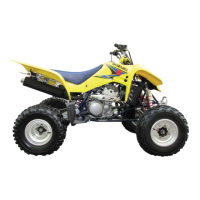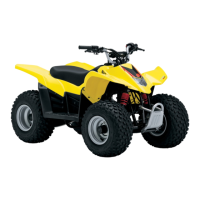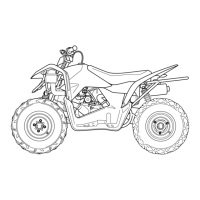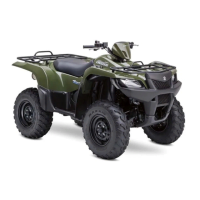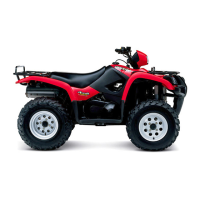BATTERY
• The MF battery used in this vehicle does not require mainte-
nance (e.g., electrolyte level inspection, distilled water replen-
ishment).
• During normal charging, no hydrogen gas is produced. How-
ever,
if
the battery
is
overcharged, hydrogen gas may be pro-
duced. Therefore, be sure there are no tire
or
spark sources
(e.g., short circuit) nearby when charging the battery.
• Be sure
to
recharge the battery in a well-ventilated
and
open
area.
• Note thaI the charging system for the
MF
battery is different
from that of a conventional battery. Do not replace the MF
battery
wi
th a conventional battery.
CONNECTING THE BATTERY
• When disconnecting terminals from the battery for disassem-
bly
or
servicing, be sure to disconnect the e battery lead
wire, first.
• When connecting the battery lead
wi
res, be sure to connect
the
® battery lead wire, first.
• If the terminal
is
corroded, remove the battery, pour warm
water over
it
and clean it with a wire brush.
• After connecting the battery, apply a light coat
of
grease to the
battery terminal
s.
• Install the cover over the ® battery terminal.
WIRING PROCEDURE
• Properly route the wire harness according to the "WIRE
ROUTING" seclion. (
c:7
8-11)
USING THE MULTI CIRCUIT TESTER
• Properly use the multi circuit tester ®
and
8 probes.
Improper use can cause damage to the vehicle and tester.
• If the voltage and currenl values are not known, begin mea-
suring
in
the highest range.
• When measuring the resistance, make sure no voltage
is
applied. If voltage is applied, the tester will be damaged.
• After using the tester, be sure to tum the switch to the
OFF
position.
I
CAUTION
I
Before
using
the
multi
circuit
tester
, read
its
instruc-
tion
manual.
ELECTRICAL
SYSTEM
7-3

